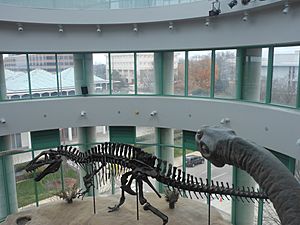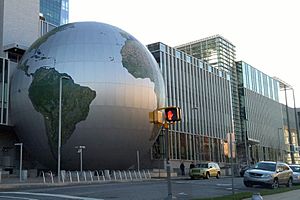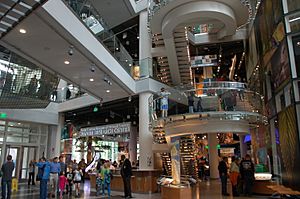North Carolina Museum of Natural Sciences facts for kids
 |
|
| Lua error in Module:Location_map at line 420: attempt to index field 'wikibase' (a nil value). | |
| Established | 1879 |
|---|---|
| Location | Raleigh, North Carolina |
| Type | Natural history museum |
| Visitors | 1.2 million (annually) |
The North Carolina Museum of Natural Sciences (NCMNS) is a museum in Raleigh, North Carolina. The museum is the oldest in the state.
The museum is made up of six facilities, divided between five campuses. The newest facility, the North Carolina Museum of Natural Sciences at Greenville, was announced in 2020 and opened to the public on September 18, 2021. NCMNS is a division of the state Department of Natural and Cultural Resources.
Contents
History
The North Carolina State Museum was created in 1879 by combining two existing state-owned collections of geologic and agricultural specimens. The museum was originally housed in the Briggs Building on Fayetteville Street. The museum's collections, outreach and education programs, and status grew over the next 60 years under the stewardship of Herbert Brimley. In 1887 the museum was placed under the management of the Department of Agriculture, and was moved to the department's office building: a former hotel on Edenton Street across from the capitol building. An annex was added in 1899 as the collection grew, and the entire facility was moved to a purpose-built building in 1924. The facility was later renamed the North Carolina State Museum of Natural History.
In the 1950s and again in the 1990s, shifts in education further expanded the museum's holdings as universities donated their collections to the state. In 1986, the museum was renamed to The North Carolina State Museum of Natural Sciences.
In 2000, the museum expanded with the opening of the Museum of Forestry in Whiteville. This facility was later overhauled and reopened in 2015 as the NC Museum of Natural Sciences in Whiteville. Another location was added in 2004, with the opening of the Prairie Ridge Ecostation for Wildlife and Learning. The museum expanded its downtown campus in 2012 with the adjacent Nature Research Center. The collection contains over 1.7 million specimens, including amphibians, reptiles, birds, fish, mammals, invertebrates, invertebrate and vertebrate fossils, plants, geology, and meteorites.
NCMNS is administered by the Department of Natural and Cultural Resources.
On July 14, 2014, a dinosaur replica along with other items were stolen from NCMNS by two accomplices. The offenders turned themselves in on July 17. The replica, along with the other items were recovered.
Nature Exploration Center
The Center is located on Jones Street in downtown Raleigh.
First floor
- Natural Treasures of North Carolina – Contains dioramas of various wildlife and artifacts pertaining to nature in North Carolina.
- Coastal North Carolina – Exhibits fish native to North Carolina's coast and inland waterways.
- WRAL 3-D Theater – A 250 seat 3-D film venue.
- Box Office – Sells tickets to the WRAL 3-D theater and the special exhibits.
Second floor
- North Carolina: Mountains to the Sea – Displays North Carolina's natural habitats from the western mountains through the central Piedmont and on to the Coastal Plain.
- Underground North Carolina – Contains gems and minerals from North Carolina, as well as ground, soil, and seismic displays.
- Nature's Explorers – Exhibits the museum's beginnings, and early methods of specimen collection and preservation.
- Discovery Room – A family-oriented hands-on exhibit.
- Special Exhibition gallery.
- Covered bridge to the Nature Research Center
Third floor
- Prehistoric North Carolina – Chronicles prehistoric life in the state and throughout the southeastern United States, and contains the reconstruction of an Eremotherium giant ground sloth excavated by the museum.
- Terror of the South – exhibits fossil skeletons, including an Acrocanthosaurus.
- Tropical Connections – Contains a large interactive globe displaying climate regions of the Earth.
- Windows on the World – A theater, used for demonstrations, talks, and live animal visits.
- Curiosity Classrooms – Two classroom spaces.
- An open air Bridge to the Nature Research Center
- A dinosaur short film
Fourth floor
- Arthropod Zoo – Live and static exhibits of the insects, crustaceans, arachnids and other arthropods in North Carolina.
- Living Conservatory – A dry tropical forest exhibit with various live plants and animals, including butterflies and two-toed sloth. A chamber displays chrysalides of developing butterflies and butterflies that have recently emerged.
Nature Research Center
The Nature Research Center (NRC) is an 80,000 sq ft (7,400 m2), four-story wing across the street from the Nature Exploration Center. The NRC and NEC are connected by a breezeway. The initial opening (April 20, 2012) lasted for 24 hours and drew 70,000 visitors.
The NRC provides hands-on activities and visitor-viewing of scientists working in the NRC's four research laboratories. The museum also makes use of distance learning to broadcast lessons and virtual field trips to classrooms around the state.
First floor
- SECU Daily Planet Theater – Inside the globe, a three-story theater hosts science presentations and scenes from nature.
- Our Changing Ocean – A 10,000 US gal (38,000 L) aquarium replicates a typical hardbottom habitat off the North Carolina coast.
- Investigating Right Whales – Visitors can see and touch the skeleton of "Stumpy", a North Atlantic right whale whose death led to laws that require slower cargo ship speeds in whale migration routes.
- Exploring the Deep Sea – A model submersible takes visitors on a virtual dive 2,000 ft (610 m) to the ocean floor off the North Carolina coast.
- Exploratory Gallery – Presents projects and breakthroughs in engineering, health, and modeling.
- Citizen Science Center – Exhibits on getting involved in scientific research and being a citizen scientist.
- North Carolina's Green Gems – Contains emeralds discovered in North Carolina, including North America's largest cut emerald, the 64.8-carat Carolina Emperor.
- Gift shop
- SECU DinoLab – Announced in 2020 and set to open by 2024, the SECU DinoLab is a planned exhibit meant to house the Dueling Dinosaurs, a scientifically important specimen of a Tyrannosaurus and Triceratops locked in combat.
Second floor
- Researching Weather – Displays methods used to study the weather.
- Window on Animal Health – Visitors can view veterinary staff, students, and interns working on real medical procedures. The window is equipped with 2-way audio between visitors and staff and offers video for visitors to view close-ups of images and medical procedures. Patients include species such as reptiles, amphibians, fish, birds, small mammals and invertebrates.
- Naturalist Center – Features some of the museum's 20,000 education specimens such as fossils, bones, preserved reptiles, and birds. This exhibit also showcases audio and video of certain specimens at two interactive tabletops.
Third floor
- Unraveling DNA – DNA replication and model organisms.
- From Dinosaurs to DNA – Demonstrates new tools and techniques in natural sciences research.
- Postcards from Space – Collection of meteorites.
- Ice Age Giants – Exhibits Ice Age animals and the ending of the Ice Age.
- Early Life Explosion – Displays of Ediacaran fossils representing some of the earliest complex life on Earth (542-635 million years ago).
Investigate labs
The Nature Research Center's three investigate labs are open-to-the-public hands-on educational spaces.
- Natural World Investigate Lab (second floor) – Visitors can use a variety of tools to observe and study the natural world.
- Micro World Investigate Lab (third floor) – This lab focuses on advances in biotechnology and microbiology, including protozoa and genetic engineering.
- Visual World Investigate Lab (third floor) – Demonstrates modelling and simulation technologies, and offers classes in electronics and computer programming.
Research labs
The Nature Research Center's four research labs are part of the museum's Research and Collections department. These spaces (normally used for behind-the-scenes work) have transparent glass walls through which the public can observe research scientists. The atrium is home to the LCD sculpture Patterned by Nature.
- Biodiversity and Earth Observation Research Laboratory (second floor) – This laboratory is the center for exploration of the flora and fauna of the community, state and planet. Studies focus on such areas as mammalian movement ecology.
- Astronomy and Space Observation Research Laboratory (third floor) – Astronomers in this lab use large telescopes around the world to investigate the origins of the Solar System by studying the chemical composition of gas clouds around forming stars.
- Genomics and Microbiology Research Laboratory (third floor) – In this lab, biologists conduct a wide spectrum of molecular genetic studies to examine DNA-based relationships among primates (called comparative evolutionary genomics).
- Paleontology and Geology Research Laboratory (third floor) – The focus of this laboratory is the morphology, evolutionary relationships and paleoecology of theropod dinosaurs—a group that includes the iconic mega predator Tyrannosaurus rex as well as all living birds.
Satellite facilities and branches
Prairie Ridge Ecostation
Prairie Ridge Ecostation (45 acres (180,000 m2)) is a satellite facility and outdoor classroom located 6 miles (9.7 km) from the museum's downtown Raleigh locations. It includes Piedmont prairie, forest, ponds, a stream, and sustainable building features integrated with a wildlife-friendly landscape.
Prairie Ridge is part of the museum's mission of enhancing public understanding and appreciation of the natural environment by providing an outdoor learning space while acting as a model for renewable and sustainable energy.
The facility opened a Nature PlaySpace on Saturday, September 28, 2013.
North Carolina Museum of Natural Sciences at Whiteville
The North Carolina Museum of Natural Sciences at Whiteville, North Carolina formerly known as the North Carolina Museum of Forestry, is a satellite facility of the North Carolina Museum of Natural Sciences. Its mission is to celebrate the natural history and cultural heritage of North Carolina's forests through interpretive exhibits, educational programming, and the preservation of natural and man-made materials that demonstrate the ongoing relationship of forests and people.
Displays and interactive exhibits include an outdoor Tree Trail and Fossil Dig Pit, and the museum offers educational program experiences and special events.
North Carolina Museum of Natural Sciences at Contentnea Creek
The North Carolina Museum of Natural Sciences at Contentnea Creek, formerly known as the Grifton Nature & Science Center, is a satellite facility and outdoor classroom located in Grifton, North Carolina. It features hiking and paddling trails centered around Contentnea Creek, along with an observatory and outdoor classroom.
North Carolina Museum of Natural Sciences at Greenville
The North Carolina Museum of Natural Sciences at Greenville, North Carolina formerly known as A Time For Science (ATFS), is a satellite facility of the North Carolina Museum of Natural Sciences located in Greenville, North Carolina. It and the Grifton Nature and Science Center were acquired through a partnership between NCMNS and ATFS. The center was renovated with new exhibits being added and reopened in September 2021. The Museum at Greenville is largely based on the Raleigh facility, but with more exhibits focusing on subjects relevant to northeastern North Carolina such as pirates and pollinators, and includes resources from East Carolina University.
Notable annual events
NCMNS hosts many special events through the year. The most notable are:
- On Groundhog Day, February 2, Sir Walter Wally makes his annual prediction for the arrival of the upcoming spring. Sir Walter has a 58% accuracy rating, which has earned him nationwide recognition for his prognostication ability.
- BugFest, held in mid-September every year, is a free day-long festival devoted to insects. This event attracts more than 35,000 visitors per year. A smaller version of the festival, called BugFest South, is held at the Whiteville facility in May or June.
- NCMNS participates in First Night Raleigh each year on December 31. In 2012, First Night drew 80,000 people to the blocks around the museum.
Acquisition of the Dueling Dinosaurs
The Dueling Dinosaurs is an extremely well-preserved and scientifically important specimen from Montana of a Triceratops and Tyrannosaurus possibly locked in combat. First found in 2006 by Clayton Phipps, there were unsuccessful attempts to sell it to museums or private collectors for over a decade until the NCMNS reached out in 2016, prompting negotiations to purchase the fossil, with funds being raised by the nonprofit Friends of the North Carolina Museum of Natural Sciences. Legal issues concerning mineral rights significantly slowed these negotiations until they were resolved in 2020, leading the museum to announce its acquisition of the fossils as part of its permanent collection. The fossils are set to be put on display in the Nature Research Center. After construction delays, the Dueling Dinosaurs exhibit will open in 2024.






